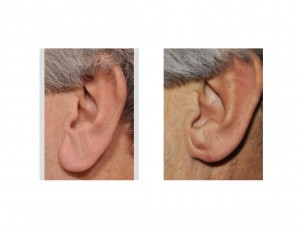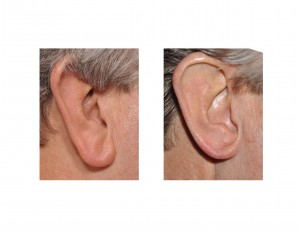Background: The ears are often a forgotten facial structure if they are normal in shape and blend into the side of the face. But when they stick out too far or have an abnormal shape or proportions, they become noticeable and an aesthetic liability. Such is the case with the large earlobe.
The earlobe is an anatomically distinct element of the ear. Not only because it hangs down on the bottom of the ear and is a common adornment site for jewelry, but also because it contains no cartilage. The rest of the ear with its complex morphology of hills and valleys is supported by underlying cartilage. While this cartilage is covered by skin, most of it is fairly flexible and bendable. But with age, its shape does not change. Such is not the case with the earlobe.
The earlobe contains only skin and fat. Thus like much of the rest of the face, it can stretch and sag with aging. It does not have the benefit of stiffer cartilage support. It can ‘grow’ with aging and this lengthening effect is often exaggerated by heavy ear ring wear. So it is true that the ears do grow with age by virtue of being stretched. Large earlobes can also occur by simply being born that way. Such is the case in most men with large earlobes while earlobe stretching is a more common cause of large earlobes in women.



Earlobe reduction is a simple and highly effective procedure whose results will be permanent. It has minimal after surgery care and heals very quickly. The scars fade remarkably fast and are rarely a secondary aesthetic concern. It can be combined with other ear or facial procedures.
Case Highlights:
• Large earlobes can occur naturally or as a result of aging.
• Earlobes can be reduced by a variety of excisional methods with minimal scarring.
• Earlobe reductions can be done under local anesthesia as an office procedure or as part of other facial procedures under general anesthesia.
Dr. Barry Eppley
Indianapolis, Indiana


